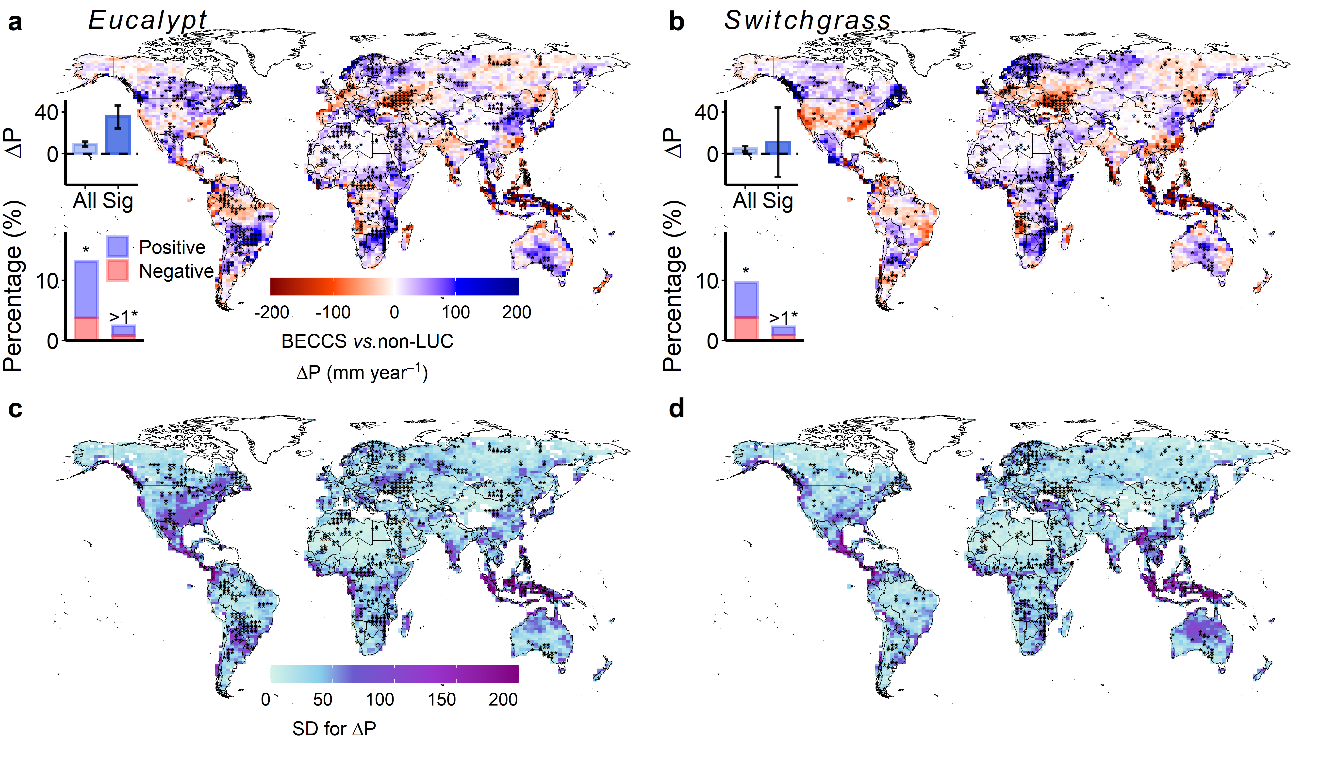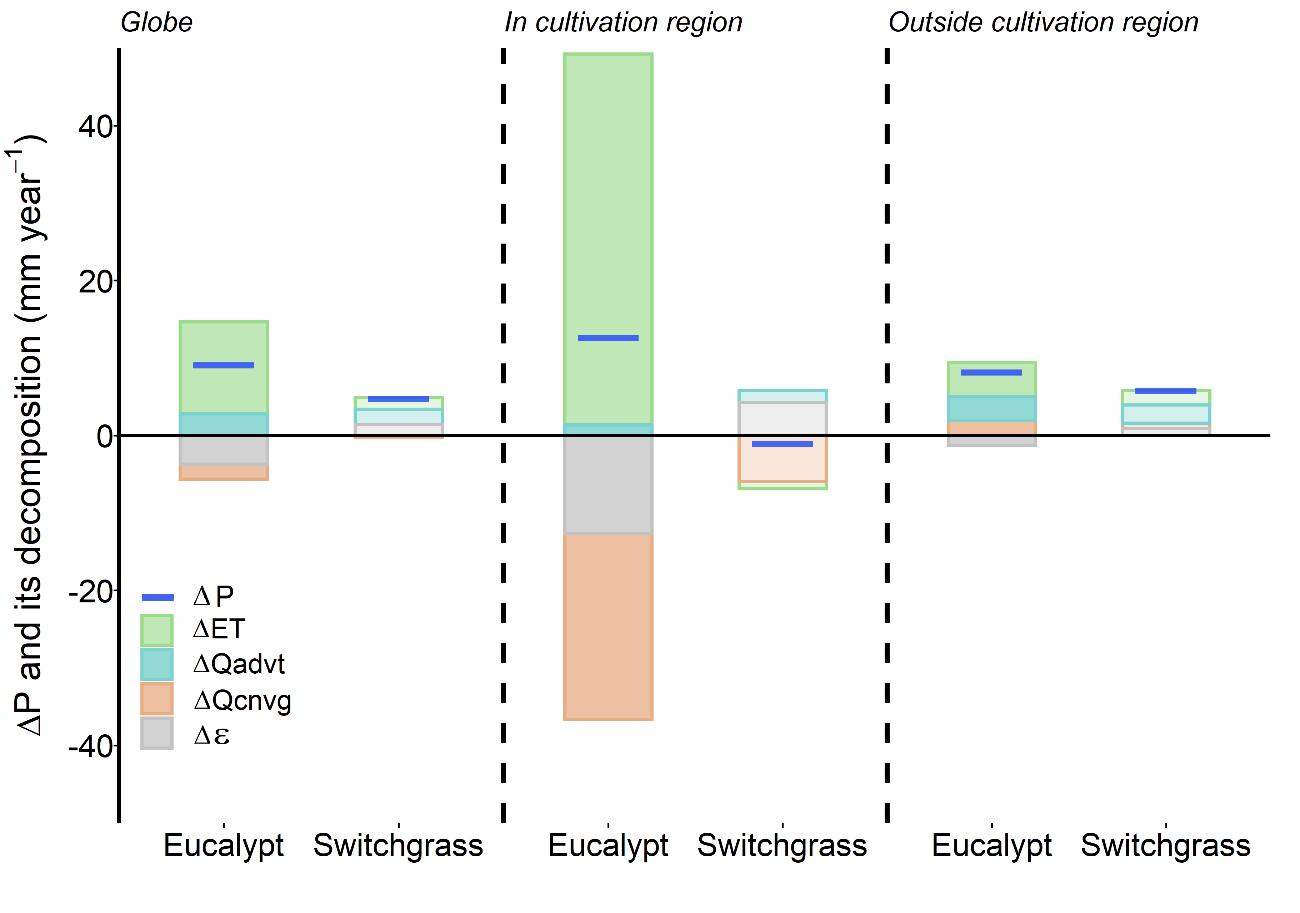Bioenergy with carbon capture and storage (BECCS) is one of the main negative emission technologies to achieve carbon neutrality and mitigate climate change. Its basic principle is to fix carbon dioxide in the atmosphere in biomass by planting fast-growing energy crops (such as eucalyptus, willow and switchgrass), and to store the discharged CO2 after the burning of the biomass, so as to achieve the purpose of CO2 removal (CDR) from the atmosphere. However, there are still many uncertainties in the large-scale implementation of the BECCS technology. For example, the growth process of fast-growing species needs to consume a large quantity of water resources, which may pose a threat to fresh water resources. Previous studies only paid attention to the water demand of bioenergy crop growth itself, but did not consider the feedback effect of large-scale energy crop planting on climate through biophysical processes.
Associate Professor Li Wei’s Research Group of the Department of Earth System Science (DESS), Tsinghua University has, in conjunction with several research institutions at home and abroad, conducted research on the above problems, revealing the impact of global large-scale bioenergy crop planting on the global terrestrial water cycle, and exploring the impact of different planting strategies (i.e. different bioenergy crop types, planting area distribution/planting area) on terrestrial precipitation and other terrestrial water balance components (evapotranspiration, surface runoff and soil water storage) through biophysical effects.
In this study, a dynamic vegetation model embedded in the self-developed second-generation energy crop module was used, which was coupled with the atmospheric model to simulate the terrestrial biophysical characteristics and key hydrological variables of six bioenergy crop planting scenarios. It has been found in the research that global-mean precipitation over land increases by 9.0 ± 2.4 mm year−1 (mean and standard deviation among the three cultivation maps) in the eucalypt scenarios and by 4.7 ± 2.7 mm year−1 in the switchgrass scenarios, with significant precipitation changes detected over 15.5% and 11.9% of the global land area respectively (Fig. 1). Meanwhile, the results of precipitation diagnosis by using atmospheric water vapor budget equation show that surface evapotranspiration is the main source of increased precipitation in the eucalyptus planting scenario. In the switchgrass planting scenario, the increased precipitation comes from both surface evapotranspiration and moisture advection (Fig. 2). Increased precipitation and reduced surface runoff offset the water consumed by the growth of bioenergy crops to some extent. The research shows that the biogeochemical effect caused by land use change is an important part of climate system and terrestrial water cycle. When considering climate change mitigation measures based on terrestrial ecosystem, it is necessary to comprehensively evaluate their biogeochemical and biophysical effects in order to formulate more effective climate change mitigation policies.
The above research results have been published as a paper titled “Increased precipitation over land due to climate feedback of large-scale bioenergy cultivation” in Nature Communications. Postdoctoral fellow Li Zhao of DESS, Tsinghua University is the first author of the paper, and Associate Professor Li Wei is the corresponding author. Other collaborators include Professor Philippe Ciais of Laboratoire des Sciences du Climat et de l’Environnement (LSCE), Researcher Laurent Z.X. Li of Laboratoire de Météorologie Dynamique, Centre National de la Recherche Scientifique, Associate Professor Jonathon S. Wright, Associate Professor Wang Yong, Professor Lu Hui, Professor Huang Xiaomeng, Doctor Wang Jingmeng, and doctoral candidates Liu Shu and Zhu Lei of the DESS, Tsinghua University. This study was funded by the National Natural Science Foundation of China, the National Key R&D Program of China, the Tsinghua University Initiative Scientific Research Program, and the China Postdoctoral Science Foundation.

Fig. 1: Spatial patterns of the changes in annual precipitation induced by eucalypt and switchgrass cultivation. (Stippling indicates that changes are statistically significant)

Fig. 2: Diagnosis of global terrestrial precipitation changes ( ΔP: precipitation changes; ΔET: changes in evapotranspiration, ΔQadvt: changes in moisture advection; ΔQcnvg: changes in moisture convergence, and Δε: changes in residual term).
Full-text link: https://doi.org/10.1038/s41467-023-39803-9